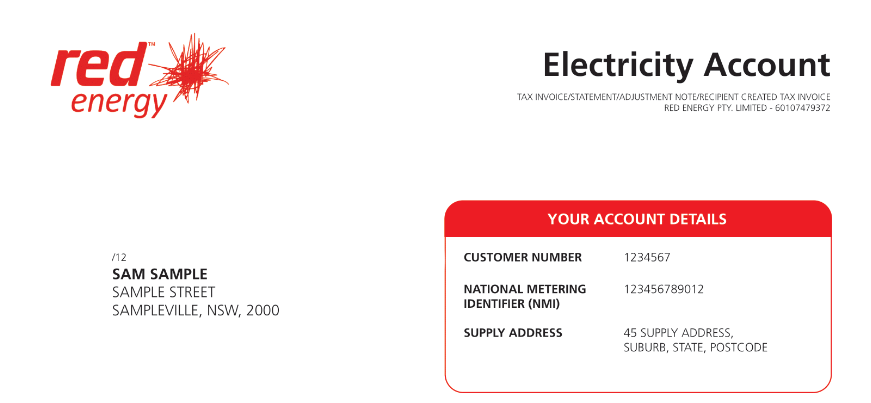An NMI number is used by power companies to accurately link a customer to their electricity meter and power usage. And while you don’t need to memorise your NMI number, knowing the basics about NMIs and where to find yours will help you switch electricity retailers and make managing your bills online simpler. In this article, Canstar Blue covers everything you need to know about NMI numbers.
On this page:
What is the National Metering Identifier?
An NMI is a unique 10- or 11-digit number attributed to each electricity connection in Australia. The number helps match a property to its energy account, ensuring that electricity customers are billed for their correct power usage.
Each electricity meter has a unique NMI number. Therefore, if you have multiple electricity meters on your property, or for your business, each will have its own NMI, which will be shown on the billing from your power supplier.
Why is the NMI number important?
An NMI is needed to identify your electricity connection and collect your meter’s usage data. You may also need to provider an NMI if you:
- Request electrical connection work at your property
- Switch electricity retailers
- Submit your own meter reading.
While providing an NMI can speed up the process of switching retailers, it’s usually not necessary. If you switch to a new electricity company, your new provider should be able to determine your NMI once they know your supply address.
Where do I find my NMI?
You can find your NMI on your electricity bill. It will usually be found with your account details on the first page of with the technical breakdown of your bill. See the example bill below.

If you don’t have a copy of your power bill handy, contact your electricity retailer and they can help you find your NMI.
Where can I find my NMI number on my meter?
Your NMI number will be located on your meter, but it isn’t the same as your electricity meter serial number. To avoid confusing the two, it’s best to get your NMI from your energy bill, as shown in the steps above.
Compare electricity providers in your state
Here are some of the cheapest published deals from the retailers on our database that include a link to the retailer’s website for further details. These are products from referral partners†. These costs are based on the Ausgrid network in Sydney but prices may vary depending on your circumstances. This comparison assumes general energy usage of 3900kWh/year for a residential customer on a single rate tariff. Please use our comparison tool for a specific comparison in your area. Our database may not cover all deals in your area. As always, check all details of any plan directly with the retailer before making a purchase decision.
Here are some of the cheapest published deals from the retailers on our database that include a link to the retailer’s website for further details. These are products from referral partners†. These costs are based on the Citipower network in Melbourne but prices may vary depending on your circumstances. This comparison assumes general energy usage of 4000kWh/year for a residential customer on a single rate tariff. Please use our comparison tool for a specific comparison in your area. Our database may not cover all deals in your area. As always, check all details of any plan directly with the retailer before making a purchase decision.
Here are some of the cheapest published deals from the retailers on our database that include a link to the retailer’s website for further details. These are products from referral partners†. These costs are based on the Energex network in Brisbane but prices may vary depending on your circumstances. This comparison assumes general energy usage of 4600kWh/year for a residential customer on a single rate tariff. Please use our comparison tool for a specific comparison in your area. Our database may not cover all deals in your area. As always, check all details of any plan directly with the retailer before making a purchase decision.
Here are some of the cheapest published deals from the retailers on our database that include a link to the retailer’s website for further details. These are products from referral partners†. These costs are based on the SA Power network in Adelaide but prices may vary depending on your circumstances. This comparison assumes general energy usage of 4000kWh/year for a residential customer on a single rate tariff. Please use our comparison tool for a specific comparison in your area. Our database may not cover all deals in your area. As always, check all details of any plan directly with the retailer before making a purchase decision.
Will my NMI change?
It’s important to note that your NMI does not identify you as a customer; rather, it identifies your electricity meter. This means that your NMI will change if you move house to an address with a different meter.
Your NMI will not change, however, if you’re simply upgrading your electricity meter or your power supply is disconnected and then reconnected.
If you’re building a house with a new power connection, you’ll need to arrange for the installation of a new electricity meter. Your power retailer will then allocate the meter a new NMI.
What is a MIRN?
The gas meter equivalent of an NMI is an MIRN, which stands for Meter Identification Reference Number. In some states it’s called a Delivery Point Identifier (DPI), instead.
It’s an 11-digit number that’s assigned to a natural gas meter as a means to identify the gas delivery point as part of the natural gas network.
Again, it’s useful, but not necessary, to have your MIRN handy if you’re switching gas companies. You can find your MIRN, or DPI, on your natural gas bill. Alternatively, you can contact your gas company and they can help you find your MIRN.


Share this article